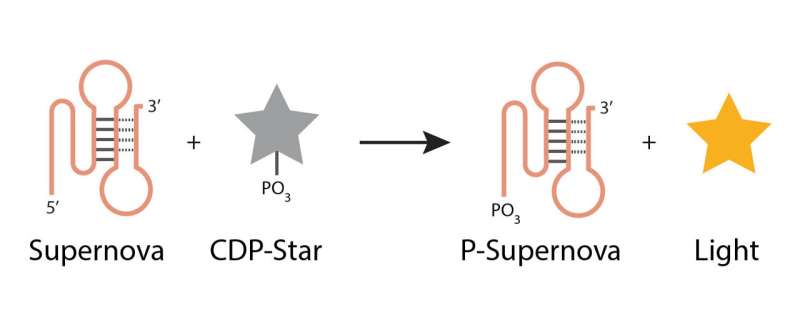Supernova: A glowing DNA enzyme

Once thought to function primarily as a storage molecule for genetic information, it is now known that DNA can also catalyze chemical reactions. Although such DNA enzymes (deoxyribozymes) have not been identified in nature, they can be isolated in the lab using powerful methods of artificial evolution.
In a recent study published in Angewandte Chemie (with Kateřina Švehlová as the first author), the Curtis Group at IOCB Prague used artificial evolution to search a library of 1016 single-stranded DNA molecules for light-producing deoxyribozymes. After multiple rounds of selection, a rare sequence was identified that phosphorylates itself in the presence of a 1,2-dioxetane substrate. This triggers a decomposition reaction and a flash of blue light. Researchers named this deoxyribozyme Supernova.
The team also developed a programmable version of Supernova which is only catalytically active in the presence of an oligonucleotide complementary to its 3' end. This shows that the production of light can be linked to the presence of a ligand. Importantly, the reaction occurs in solution and does not require wash steps or biochemical purifications. In principle, it should be possible to extend this approach to the detection of other types of ligands. Such sensors could be particularly useful for applications such as point-of-care assays and high-throughput screens.
The Curtis lab at IOCB Prague also recently developed a novel methodology that allowed them to identify deoxyribozymes that cleave RNA in a single round of selection (rather than the ten or more that are typically required). The fastest of these deoxyribozymes catalyzed RNA cleavage 5,000 times faster than the nonenzymatic rate. This general approach should be particularly useful for the optimization of existing motifs. In addition, it could facilitate the development of new sensors that use Supernova to generate light in the presence of a ligand of interest. These recent discoveries highlight the potential of artificial evolution to enhance the molecular toolkit of functional DNA parts.
More information: Katerina Svehlova et al, Supernova: a deoxyribozyme that catalyzes a chemiluminescent reaction, Angewandte Chemie International Edition (2021). DOI: 10.1002/anie.202109347
Journal information: Angewandte Chemie International Edition , Angewandte Chemie





















